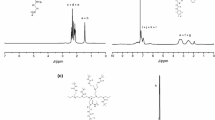Abstract
In this work, the influence of trimethylolpropane tris-(3-mercaptopropionate) and a vinyl epoxy compound (4-vinyl-1-cyclohexene 1,2-epoxide) over the photocuring and subsequent thermal curing of an epoxy resin (CYRACURE UVR-6105) is studied. The photoinitiator used is CYRACURE UVI-6976. The techniques used in this study have been DSC (differential scanning calorimetry) and FTIR (Fourier transform infrared spectroscopy). In the isothermal photocuring, when the proportion of the modifiers are 5 % or greater, the photopolymerization of the epoxy resin is stopped by the thiol-ene reaction of both modifiers, due to the formation of alkyl sulfonium salts, decreasing the maximum degree of conversion of the process. After the photocuring process, the different systems studied have been post-cured thermally and the activation energy of this process has been determined using a differential isoconversional method. When the epoxy resin is neat or only it has been added 2.5 % of the modifiers, at the beginning of the post-curing the activation energy decreases, but when the proportion of the modifiers is 5 % or greater, the activation energy always increases.











Similar content being viewed by others
References
Riew CK, Siebert AR, Smith RW, Fernando M, Kinloch AJ. Toughened epoxy resins: performed particles as tougheners for adhesives and matrices. In: Riew CK, Kinloch AJ, editors. Toughened plastics II novel approaches in science and engineering. Advances in chemical series, vol. 252. Washington: American Chemical Society; 1996. p. 33–44.
Saiki N, Yamazaki O, Ebe K. UV/heat dual-curable adhesive tapes for fabricating stacked packages of semiconductors. J Appl Polym Sci. 2008;108:1178–83.
Kang B-U. Interfacial fracture behavior of epoxy adhesives for electronic components. J Korea Acad Ind Cooper Soc. 2011;12:1479–87.
Tech Tip 20. B-stage epoxy. In: Epo-tek tech tips. Epoxy technology. 2012. http://www.epotek.com/site/files/Techtips/pdfs/tip20.pdf. Accessed 21 July 2014.
Studer K, Decker C, Beck E, Schwalm R. Thermal and photochemical curing of isocyanate and acrylate functionalized oligomers. Eur Polym J. 2005;41:157–67.
Decker C, Masson F, Schwalm R. Dual-curing of waterborne urethane-acrylate coatings by UV and thermal processing. Macromol Mater Eng. 2003;288:17–28.
Kropp M, Behr A. UV B-stage technology provides process & performance advantages. In: Innovations in IC packaging adhesives. Solid state technology. 2005. http://electroiq.com/blog/2005/08/innovations-in-ic-packaging/adhesives/. Accessed 21 July 2014.
Kolb HC, Finn MG, Sharpless KB. Click chemistry: diverse chemical function from a few good reactions. Angew Chem Int Ed. 2001;40:2004–21.
Hoyle CE, Bowman CN. Thiol-ene click chemistry. Angew Chem Int Ed. 2010;49:1540–73.
Cramer NB, Couch CL, Schreck KM, Carioscia JA, Boulden JE, Stansbury JW, Bowman CN. Investigation of thiol-ene and thiol-ene-methacrylate based resins as dental restorative materials. Dent Mater. 2010;26:21–8.
Trey SM, Gamstedt EK, Mäder E, Jönsson S, Johansson M. Glass fiber reinforced high glass transition temperature thiol-ene networks. Compos Part A Appl Sci Manuf. 2011;42:1800–8.
Sangermano M, Cerrone M, Colucci G, Roppolo I, Acosta Ortiz R. Preparation and characterization of hybrid thiol-ene/epoxy UV-thermal dual-cured systems. Polym Int. 2010;59:1046–51.
Acosta Ortiz R, Puente Urbina BA, Cabello Valdez LV, Berlanga Duarte L, Guerrero Santos R, García Valdez AE, Soucek MD. Effect of introducing a cationic system into a thiol-ene photopolymerizable formulation. J Polym Sci, Part A: Polym Chem. 2007;45:4829–43.
Cramer NB, Davies T, O’Brien AK, Bowman CN. Mechanism and modeling of a thiol-ene photopolymerization. Macromolecules. 2003;36:4631–6.
Cramer NB, Scott JP, Bowman CN. Photopolymerizations of thiol-ene polymers without photoinitiators. Macromolecules. 2002;35:5361–5.
Crivello JV. The discovery and development of onium salt cationic photoinitiators. J Polym Sci, Part A: Polym Chem. 1999;37:4241–54.
Flores J, Tomuta AM, Fernández-Francos X, Ramis X, Sangermano M, Serra A. A new two-stage curing system: thiol-ene/epoxy homopolymerization using an allyl terminated hyperbranched polyester as reactive modifier. Polymer. 2013;54:5473–81.
Foix D, Ramis X, Serra A, Sangermano M. UV generation of a multifunctional hyperbranched thermal crosslinker to cure epoxy resins. Polymer. 2011;52:3269–76.
Vyazovkin S, Burnham AK, Criado JM, Pérez-Maqueda LA, Popescu C, Sbirrazzuoli N. ICTAC Kinetics Committee recommendations for performing kinetic computations on thermal analysis data. Therm Acta. 2011;520:1–19.
Morancho JM, Cadenato A, Ramis X, Morell M, Fernández-Francos X, Salla JM, Serra A. Thermal curing and photocuring of a DGEBA modified with multiarm star poly(glycidol)-b-poly(ε-caprolactone) polymers of different arm lengths. J Therm Anal Calorim. 2013;114:409–16.
Voytekunas VY, Ng FL, Abadie MJM. Kinetics study of the UV-initiated cationic polymerization of cycloaliphatic diepoxide resins. Eur Polym J. 2008;44:3640–9.
Lovell LG, Newman SM, Bowman CN. The effects of light intensity, temperature and comonomer composition on the polymerization behavior of dimethacrylate dental resins. J Dent Res. 1999;78:1469–76.
Lecamp L, Youssef B, Bunel C, Lebaudy P. Photoinitiated polymerization of a dimethacrylate oligomer: 2. Kinetic studies. Polymer. 1999;40:1403–9.
Scott TF, Cook WD, Forsythe JS. Photo-DSC cure kinetics of vinyl ester resins. I. Influence of temperature. Polymer. 2002;43:5839–45.
Van Assche G, Swier S, Van Mele B. Modeling and experimental verification of the kinetics of reacting polymer systems. Therm Acta. 2002;388:327–41.
Santiago D, Fernández-Francos X, Ramis X, Salla JM, Sangermano M. Comparative curing kinetics and thermal-mechanical properties of DGEBA thermosets cured with a hyperbranched poly(ethyleneimine) and an aliphatic triamine. Therm Acta. 2011;526:9–21.
Acknowledgements
The authors would like to thank MICINN (Ministerio de Ciencia e Innovación) and FEDER (Fondo Europeo de Desarrollo Regional) (MAT2011-27039-C03-01 and MAT2011-27039-C03-02 and contract JCI-2010-06187) and to the Comissionat per a Universitats i Recerca del DIUE de la Generalitat de Catalunya (2014-SGR-67).
Author information
Authors and Affiliations
Corresponding author
Rights and permissions
About this article
Cite this article
Morancho, J.M., Fernández-Francos, X., Ramis, X. et al. Photocuring and thermal post-curing of a cycloaliphatic epoxide resin with a trithiol and a vinyl epoxy compound. J Therm Anal Calorim 121, 389–395 (2015). https://doi.org/10.1007/s10973-015-4535-y
Received:
Accepted:
Published:
Issue Date:
DOI: https://doi.org/10.1007/s10973-015-4535-y




